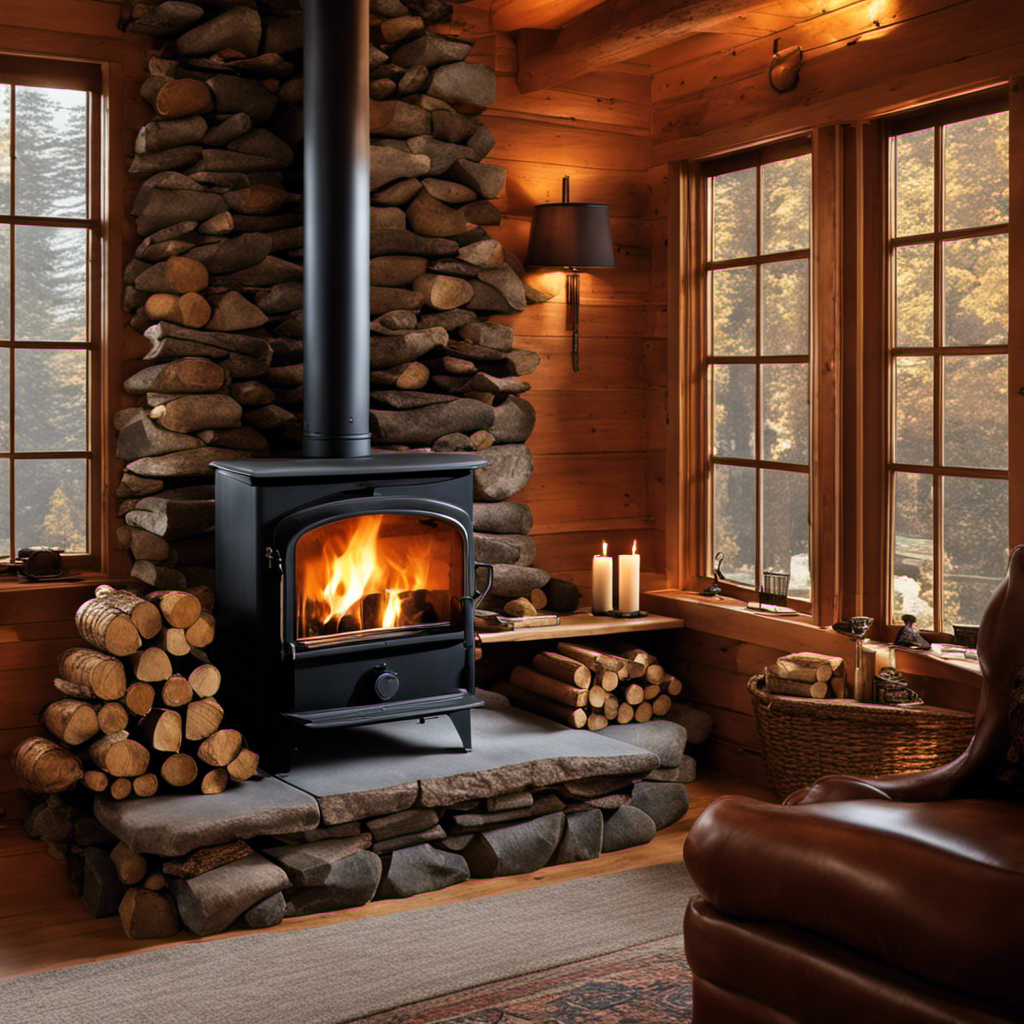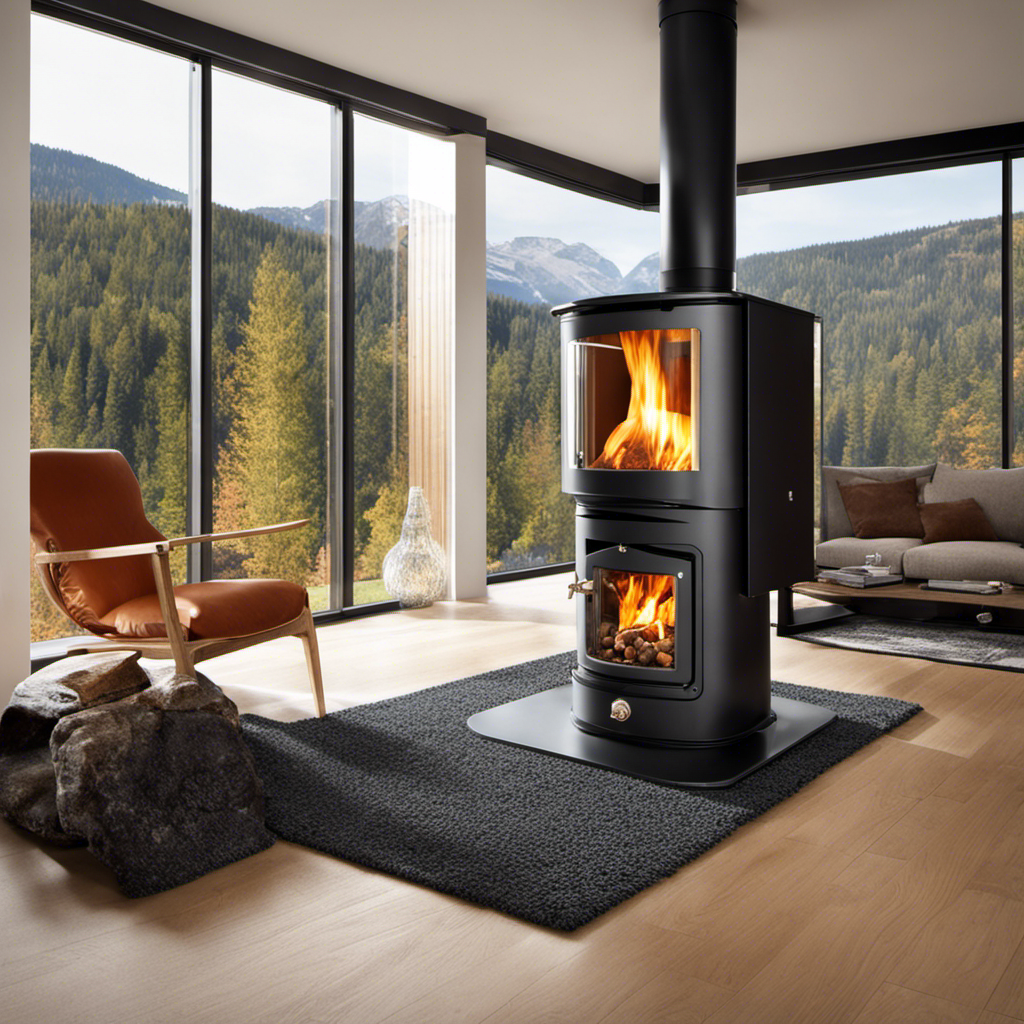As a passionate supporter of environmental protection, I always seek out environmentally sustainable sources of energy. This journey guided me to uncover wood pellet fuel, an excitingly new alternative within the realm of biomass energies.
In this article, we’ll explore the origins and production process of wood pellet fuel, its advantages over other fuels, and its impact on the environment. Whether you’re considering residential heating or industrial applications, there are important considerations to keep in mind when purchasing wood pellet fuel.
Let’s dive into the fascinating world of wood pellet fuel together!
Key Takeaways
- Wood pellet fuel is a sustainable and environmentally-friendly choice for renewable energy, with low carbon emissions and reduced greenhouse gas emissions.
- Wood pellet fuel is produced by grinding and drying waste materials from the lumber industry, such as sawdust and wood chips, and compressed into small pellets with high-quality and uniformity.
- Wood pellet fuel has a lower carbon footprint compared to traditional fossil fuels, emitting up to 90% less carbon dioxide when burned for heat or electricity generation.
- Wood pellet fuel can be used in residential heating as a cost-effective alternative, providing consistent heat with minimal ash production, and in industrial applications for power generation and commercial heating systems, reducing greenhouse gas emissions and promoting sustainability.
The Origins of Wood Pellet Fuel
You might be interested to know that wood pellet fuel originated in the 1970s as a response to the oil crisis.
The origins of wood pellet production can be traced back to Sweden, where efforts were made to find alternative sources of energy due to the limited availability and high cost of fossil fuels.
In the early days, wood pellets were primarily used for heating residential homes and commercial buildings. However, as technology advanced and environmental concerns grew, the use of wood pellets expanded to include industrial applications such as power generation and district heating systems.
Today, wood pellet fuel has become a popular choice for renewable energy due to its sustainability and low carbon emissions.
Moving on from the history of wood pellet fuel, let’s now explore its advantages without further ado.
Advantages of Wood Pellet Fuel
One of the advantages of using wood pellet fuel is that it is a more environmentally-friendly option compared to traditional fossil fuels. Wood pellet fuel is sustainable because it comes from renewable sources such as sawdust and wood chips. It reduces greenhouse gas emissions, contributing to cleaner air and mitigating climate change. Wood pellets have a lower carbon footprint than fossil fuels, making them a greener choice for heating and energy production.
Wood pellet fuel offers several advantages over conventional fuels. Its sustainability stems from its origins in waste materials generated by the lumber industry. By using these byproducts, we can reduce waste and promote resource efficiency. Additionally, wood pellets burn more efficiently than traditional firewood, producing less smoke and particulate matter. This not only improves air quality but also reduces health risks associated with indoor pollution.
Now let’s delve into how wood pellet fuel is produced…
How Wood Pellet Fuel Is Produced
The production process of wood pellet fuel involves several steps. First, waste materials from the lumber industry are ground and dried. This ensures that the final product is of high quality and meets the necessary standards. Once the materials are dry, they are compressed into small pellets.
To maintain consistency, several quality control measures are implemented throughout the production process. These measures include monitoring moisture content, particle size distribution, and density of the raw materials. It is important to adhere to temperature and pressure parameters during compression to achieve uniformity in pellet shape and density.
After the pellets are made, quality control checks are performed to ensure they meet specific requirements for combustion efficiency and emissions reduction. These checks help guarantee that every batch of wood pellet fuel produced is reliable and efficient.
Moving on to the composition of wood pellet fuel…
The Composition of Wood Pellet Fuel
When it comes to the composition of wood pellet fuel, there are several key ingredients that play a crucial role. These ingredients typically include sawdust, wood chips, bark, and other biomass materials.
The specific composition of these pellets has various benefits such as consistent burning efficiency and low moisture content. However, it is also important to consider the environmental impact of this composition in terms of carbon emissions and sustainability.
Key Ingredients of Pellets
To understand the key ingredients of pellets, you should know that they typically contain compressed sawdust and other wood waste materials. These ingredients are carefully selected to ensure optimal performance and efficiency during combustion.
Here is a breakdown of the manufacturing process and key ingredients:
-
The primary ingredient is sawdust, which is obtained from lumber mills or wood processing facilities. Sawdust is rich in lignin, a natural binder that helps hold the pellets together during compression. It also contains cellulose and hemicellulose, which contribute to the fuel’s energy content.
-
Other wood waste materials such as bark, branches, and shavings are often added to enhance the pellet’s density and energy output.
Benefits of Specific Composition
Combining specific ingredients in the manufacturing process ensures consistent quality and reliable performance of wood pellet fuel for heating or power generation. The use of specific compositions offers several benefits.
One advantage is that these pellets have a higher energy density compared to traditional firewood, meaning they can produce more heat per unit of weight. Additionally, the uniform size and shape of the pellets allow for efficient combustion and reduced emissions. This leads to cleaner burning with fewer pollutants released into the atmosphere.
However, there are also some disadvantages to consider. For instance, certain compositions may be more expensive due to the cost of sourcing or processing specific ingredients. Furthermore, some compositions may have varying levels of ash content which can affect maintenance requirements for heating appliances.
Understanding these specific benefits and disadvantages is crucial when choosing the right wood pellet composition for your needs.
Transitioning into the subsequent section about the environmental impact of composition…
Environmental Impact of Composition
One of the environmental impacts of specific compositions is that they can lead to reduced emissions and cleaner burning. Wood pellet fuel, for instance, has gained popularity due to its potential to lower carbon emissions compared to traditional fossil fuels. Carbon emissions are a major contributor to climate change and sustainability concerns. By using wood pellets as a renewable energy source, we can mitigate the negative effects on the environment.
Wood pellets are made from compacted sawdust or other biomass materials, resulting in a more efficient and clean-burning fuel. This reduces harmful pollutants released into the atmosphere, such as sulfur dioxide and particulate matter. Therefore, wood pellet fuel presents a viable solution for reducing carbon emissions and addressing sustainability challenges.
Transitioning into the subsequent section about comparing wood pellet fuel to other biomass fuels…
Comparing Wood Pellet Fuel to Other Biomass Fuels
Wood pellet fuel is often compared to other biomass fuels for its efficiency and environmental benefits. When comparing wood pellet fuel to traditional fossil fuels, such as coal or oil, wood pellets have several advantages.
Firstly, wood pellets are a renewable energy source, whereas fossil fuels are finite and contribute to greenhouse gas emissions. Secondly, wood pellet fuel produces less carbon dioxide when burned, making it a cleaner alternative.
Additionally, wood pellets have a higher energy density than other biomass fuels like sawdust or straw, meaning they can produce more heat per unit of weight. This makes them more efficient and cost-effective for heating purposes.
As the demand for renewable energy continues to grow, the future of wood pellet fuel looks promising in contributing to sustainable and clean energy solutions.
Transitioning into the subsequent section about the environmental impact of wood pellet fuel…
Environmental Impact of Wood Pellet Fuel
When considering the environmental impact of wood pellet fuel, two key points to examine are the carbon footprint of pellets and deforestation concerns.
The carbon footprint of pellets refers to the amount of greenhouse gases emitted during their production, transportation, and combustion.
Deforestation concerns arise from the potential negative effects that increased demand for wood pellets can have on forests and biodiversity.
Understanding these aspects is crucial in assessing the overall sustainability of using wood pellet fuel as an alternative energy source.
Carbon Footprint of Pellets
The carbon footprint of pellets can be significantly lower than that of traditional fossil fuels. Wood pellet fuel is considered a renewable energy source, as it comes from sustainably managed forests and utilizes biomass waste materials. This results in reduced carbon emissions compared to fossil fuels, making it an environmentally friendly alternative. In fact, wood pellets have been found to emit up to 90% less carbon dioxide when burned for heat or electricity generation.
To illustrate the sustainability benefits of wood pellet fuel, consider the following table:
| Traditional Fossil Fuels | Wood Pellet Fuel |
|---|---|
| High carbon emissions | Low carbon emissions |
| Non-renewable | Renewable |
| Contributing to climate change | Reducing greenhouse gas emissions |
As we delve deeper into the topic of wood pellet fuel, it is important to address deforestation concerns without taking another ‘step’.
Deforestation Concerns
In considering the carbon footprint of wood pellet fuel, it is important to also address the concerns related to deforestation. Deforestation refers to the clearing of forests for various purposes, including logging and agriculture. The consequences of deforestation are significant, as it leads to habitat loss for countless species, disrupts local ecosystems, and contributes to climate change by reducing the Earth’s capacity for carbon sequestration.
To address these concerns and promote sustainable alternatives, it is crucial that the production of wood pellets follows responsible forestry practices. This involves sourcing wood from sustainably managed forests or from residues such as sawdust and wood chips generated by other industries. By promoting sustainable forestry practices and using these alternative sources of wood, we can ensure that our reliance on wood pellet fuel does not contribute to further deforestation.
Transitioning into the subsequent section about using wood pellet fuel in residential heating…
Using Wood Pellet Fuel in Residential Heating
You can save money on your residential heating by using wood pellet fuel. Wood pellets are a highly efficient and cost-effective alternative to traditional heating methods.
When it comes to residential efficiency, wood pellet fuel is hard to beat. These small, compressed pellets are made from waste materials such as sawdust and agricultural residues, making them an environmentally friendly choice. Not only do they produce less smoke and emissions compared to fossil fuels, but they also provide consistent heat with minimal ash production.
In terms of cost comparisons, wood pellet fuel tends to be more affordable than oil or propane in many areas. Additionally, the availability of government incentives further reduces the overall cost of switching to wood pellet fuel for residential heating.
Transitioning into industrial applications of wood pellet fuel, its versatility extends beyond just homes and can be utilized in various sectors such as power generation and commercial heating systems without compromising efficiency or performance.
Industrial Applications of Wood Pellet Fuel
Using wood pellet fuel in industrial applications offers a versatile and efficient solution for power generation and commercial heating systems. Industrial applications of wood pellet fuel have gained popularity due to their numerous advantages, such as reducing greenhouse gas emissions and dependence on fossil fuels.
Wood pellets are made from compacted sawdust, shavings, or other waste materials from the lumber industry. They provide a renewable energy source that can be easily transported and stored. Wood pellet fuel can be used in various industries, including manufacturing plants, food processing facilities, and large-scale heating systems. It provides a cost-effective alternative to traditional fuels while promoting sustainability and reducing environmental impact.
When considering purchasing wood pellet fuel for industrial use, several factors need to be taken into account to ensure optimal performance and efficiency without compromising quality or safety.
Considerations for Purchasing Wood Pellet Fuel
When considering the purchase of wood pellet fuel for industrial use, it’s important to take into account several factors to ensure optimal performance and efficiency without compromising quality or safety. Here are some key considerations:
-
Cost considerations: Wood pellet fuel can vary in price depending on factors such as production method and availability. It is crucial to evaluate the cost per unit of energy provided by different suppliers to make an informed decision.
-
Storage requirements: Wood pellets need proper storage conditions to maintain their quality and prevent degradation. Consider the amount of space available for storage and whether additional equipment, such as silos or bins, may be needed.
-
Quality assurance: Look for suppliers who adhere to strict quality control measures, such as certification from organizations like ENplus or the Pellet Fuels Institute (PFI). This ensures that you receive high-quality pellets that meet industry standards.
-
Safety protocols: Ensure that the supplier follows safety guidelines during production, transportation, and delivery of wood pellet fuel to minimize the risk of accidents or damage.
Considering these factors will help you choose a reliable supplier and maximize the benefits of using wood pellet fuel for your industrial operations.
Frequently Asked Questions
Can Wood Pellet Fuel Be Used in Cooking or Grilling?
Yes, you can use wood pellet fuel for cooking or grilling. It provides a consistent heat source and imparts a smoky flavor to your food. It is an efficient and eco-friendly option for outdoor cooking.
Are There Any Safety Concerns When Using Wood Pellet Fuel in Residential Heating?
When it comes to using wood pellet fuel for residential heating, safety precautions are of utmost importance. Proper storage and handling can help prevent any potential hazards or accidents from occurring.
How Long Does Wood Pellet Fuel Typically Last Before Needing to Be Refilled?
Wood pellet fuel typically lasts for several hours before needing to be refilled. It is important to follow safety precautions when using wood pellets, especially when cooking with them indoors.
Can Wood Pellet Fuel Be Used in All Types of Heating Systems?
Yes, wood pellet fuel can be used in various types of heating systems. It offers several advantages, such as high energy efficiency and environmental friendliness. Its compatibility makes it a versatile option for heating purposes.
Is Wood Pellet Fuel More Expensive Than Traditional Heating Fuels Like Oil or Gas?
Wood pellet fuel, compared to oil or gas, can be pricier. However, its environmental impact is lower. It’s important to consider the cost comparison and long-term benefits of using wood pellets for heating systems.
Conclusion
In conclusion, wood pellet fuel is a sustainable and efficient alternative to traditional fossil fuels. Its production process, composition, and environmental impact make it an attractive choice for both residential and industrial applications.
For example, imagine a small town that relies on outdated coal-fired power plants for electricity. By switching to wood pellet fuel, not only would they reduce their carbon emissions significantly but also create job opportunities in the local forestry industry.
This transition would bring hope and a cleaner future for generations to come.











